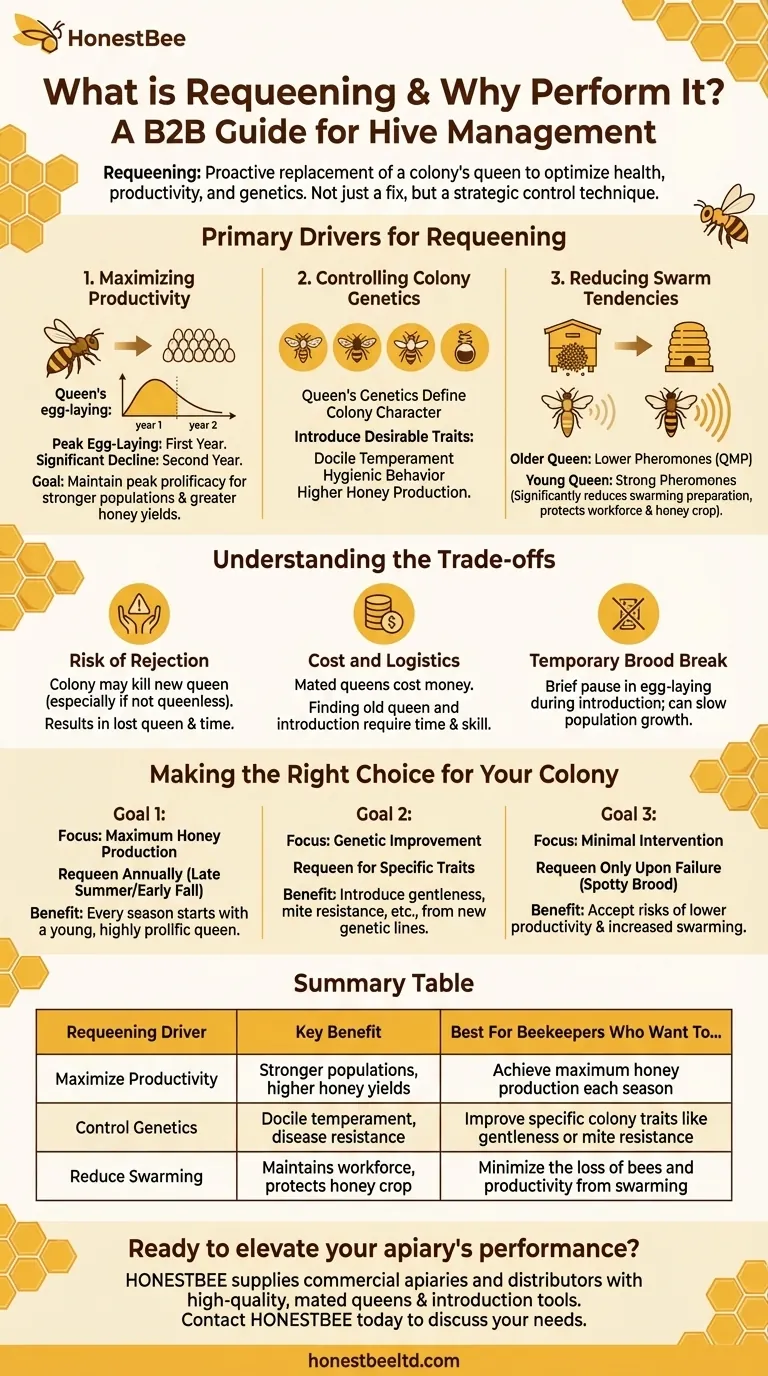At its core, requeening is the process of removing a honey bee colony’s existing queen and introducing a new one. This is a fundamental beekeeping practice performed for two primary reasons: to replace an old or failing queen whose egg-laying capacity has diminished, or to strategically change the genetic traits of the entire colony.
Requeening should not be viewed merely as a reactive fix. It is a proactive management technique that gives a beekeeper direct control over a colony's productivity, temperament, and long-term health.
The Primary Drivers for Requeening
Understanding why you should requeen is central to effective hive management. The decision is driven by a desire to optimize specific colony characteristics that are all directly tied to the queen.
Maximizing Productivity
A queen's primary role is to lay eggs, which directly determines the colony's population and, therefore, its potential workforce for foraging.
While a queen can live for several years, her egg-laying performance peaks in her first year. Studies and beekeeper experience show a significant decline in her second year and a drastic drop thereafter.
Annual requeening ensures the colony is always headed by a queen at her peak prolificacy, leading to stronger populations and greater honey yields.
Controlling Colony Genetics
The queen is the mother of nearly every bee in the hive, meaning her genetics define the colony's overall character.
By choosing a queen from a specific genetic line, a beekeeper can introduce desirable traits. This includes a more docile temperament, increased hygienic behavior to combat mites and disease, and a greater propensity for honey production.
Reducing Swarm Tendencies
Swarming is a natural reproductive instinct for honey bees, but for a beekeeper, it represents a significant loss of the workforce and a potential honey crop.
Older queens produce lower levels of the crucial queen mandibular pheromone (QMP). This pheromone signals the queen's presence and viability, suppressing the colony's impulse to raise new queens and swarm.
A young, well-mated queen produces strong pheromones, which significantly reduces the likelihood of the colony preparing to swarm.
Understanding the Trade-offs
While highly beneficial, requeening is an intervention that carries inherent risks and requires careful consideration. It is not a guaranteed success.
The Risk of Rejection
A colony may not accept a new queen and can kill her, a process known as rejection. This risk is higher if the colony is not truly queenless or if the introduction method is rushed.
A failed introduction leaves the colony queenless, forcing the beekeeper to either try again or risk the colony creating its own, often inferior, emergency queen.
The Cost and Logistics
Purchasing a quality, mated queen comes at a financial cost. Furthermore, the process itself requires time and skill.
Finding and removing the old queen can be a challenging task, especially in a populous hive. The subsequent introduction process requires patience and adherence to proven methods to maximize acceptance.
The Temporary Brood Break
During the introduction period, there will be a brief pause in egg-laying. While often negligible, this brood break can temporarily slow the colony's population growth.
Making the Right Choice for Your Colony
Your approach to requeening should align directly with your beekeeping goals. There is no single correct frequency; the right choice depends on your management philosophy.
- If your primary focus is maximum honey production: Requeen annually in the late summer or early fall to ensure every season starts with a young, highly prolific queen.
- If your primary focus is genetic improvement: Requeen whenever you want to introduce specific traits, such as gentleness or Varroa mite resistance, from a new genetic line.
- If your primary focus is minimal intervention: Requeen only when you observe clear signs of queen failure, such as a spotty brood pattern, but accept the risks of lower productivity and increased swarming.
Ultimately, mastering the art of requeening transforms you from a bee-haver into a true beekeeper, actively guiding the destiny of your colonies.
Summary Table:
| Requeening Driver | Key Benefit | Best For Beekeepers Who Want To... |
|---|---|---|
| Maximize Productivity | Stronger populations, higher honey yields | Achieve maximum honey production each season |
| Control Genetics | Docile temperament, disease resistance | Improve specific colony traits like gentleness or mite resistance |
| Reduce Swarming | Maintains workforce, protects honey crop | Minimize the loss of bees and productivity from swarming |
Ready to elevate your apiary's performance?
Requeening is a cornerstone of professional hive management. HONESTBEE supplies commercial apiaries and beekeeping equipment distributors with the high-quality, mated queens and introduction tools needed for successful requeening. By choosing the right genetics, you can directly influence your colony's honey production, disease resistance, and overall temperament.
Let our wholesale-focused expertise help you make the right choice for your operation. Contact HONESTBEE today to discuss your queen and equipment needs.
Visual Guide

Related Products
- No Grafting Queen Rearing Kit: System for Royal Jelly Production and Queen Rearing
- Jenter Queen Rearing Kit Complete Set for Bee Breeding
- Brown Nicot Queen Cell Cups for Breeding Queen Bees Beekeeping
- HONESTBEE Premium Italian Style Hive Tool with Hardwood Handle
- HONESTBEE 15-in-1 Beekeeper Multi-Tool with Hammer and Pliers for Beekeeping
People Also Ask
- What are the developmental periods for different bee castes? Master the 16, 21, and 24-Day Timelines for Hive Success
- What are the stages involved in queen raising? A Guide to Controlled, High-Quality Queen Production
- What is the timeline for queen breeding? A 28-Day Guide from Egg to Laying Queen
- What do queen rearers do with queens that fail to lay on time? The Critical Quality Control Decision
- How can beekeepers start a honey bee breeding program? Build a Superior, Resilient Apiary



















